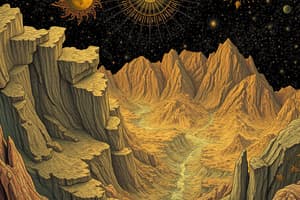Podcast
Questions and Answers
What is the term for the underground origin of an earthquake?
What is the term for the underground origin of an earthquake?
- Epicenter
- Seismograph
- Fault
- Focus (correct)
A tsunami is generated by volcanic eruptions only.
A tsunami is generated by volcanic eruptions only.
False (B)
What scale do scientists use to measure the magnitude of an earthquake?
What scale do scientists use to measure the magnitude of an earthquake?
Richter scale
A _____ earthquake occurs when tectonic plates are forced over one another at convergent boundaries.
A _____ earthquake occurs when tectonic plates are forced over one another at convergent boundaries.
What term describes a mountain formed by magma?
What term describes a mountain formed by magma?
Each increase of 1.0 on the Richter scale represents a tenfold increase in energy release.
Each increase of 1.0 on the Richter scale represents a tenfold increase in energy release.
What phenomenon reaches speeds of 700 to 800 km/hr and can exceed heights of 30 meters?
What phenomenon reaches speeds of 700 to 800 km/hr and can exceed heights of 30 meters?
Match the type of earthquake to its boundary description:
Match the type of earthquake to its boundary description:
Flashcards are hidden until you start studying
Study Notes
Earthquakes
- A fault is a break in the Earth's crust where tectonic plates slide past each other.
- Earthquakes occur when stress on a fault causes it to suddenly break, releasing seismic waves that cause ground vibrations.
- The focus is the point underground where an earthquake originates.
- The epicenter is the point on the Earth's surface directly above the focus.
- Seismologists study earthquakes and use seismographs to record seismic waves, producing seismograms.
- The Richter scale measures the magnitude of an earthquake, which is a measure of the energy released.
- Each increase of one whole number on the Richter scale represents a tenfold increase in energy released.
Types of Earthquakes
- Thrust Earthquakes occur at convergent boundaries where one plate is forced over another, creating a thrust fault.
- Submarine Earthquakes occur at divergent boundaries where plates are forced apart, often on the ocean floor where new floor is created.
- Strike-Slip Earthquakes occur at transform faults where plates slip past each other.
Tsunamis
- A tsunami is a series of giant waves caused by the displacement of water, often triggered by underwater earthquakes.
- They can reach speeds of 700 to 800 km/hr and heights of 30 meters or more.
- Tsunamis differ from regular waves, which are generated by wind and tides.
Volcanoes
- A volcano is a mountain formed from magma, which is molten rock found beneath the Earth's surface.
- Once magma reaches the surface, it is called lava.
- Volcanoes are commonly located near tectonic plate boundaries where plates are either sliding or separating.
Volcanic Eruptions
- Volcanic eruptions occur when the pressure of the magma inside becomes too great and it erupts.
- Some volcanoes constantly release magma, preventing pressure buildup and eruptions.
- The Ring of Fire is a zone of intense volcanic and earthquake activity that circles the Pacific Ocean.
Studying That Suits You
Use AI to generate personalized quizzes and flashcards to suit your learning preferences.




